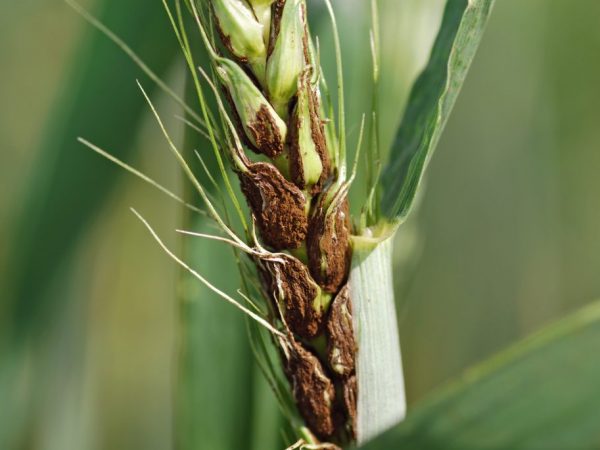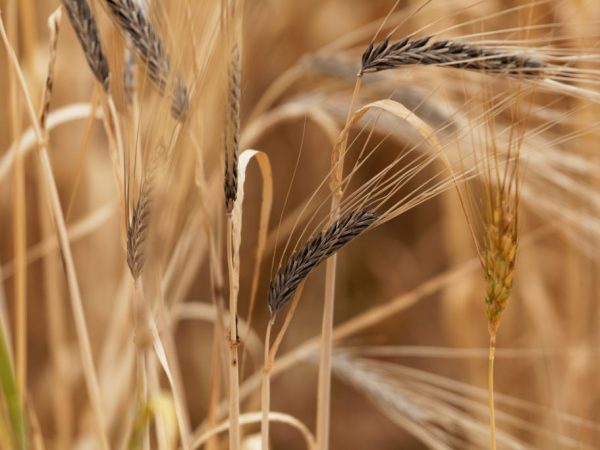Head mushroom
There are parasitic fungi that cause significant harm to agriculture. This type includes a smut fungus, which damages mainly cereals, but sometimes wild plants become infected.

Head mushroom
Characteristics of the disease
Parasitic smut fungi belong to Basidiomycetes. There are about 1000 species of them (40 genera). They are able to settle on grain crops over their entire surface: on buds, leaves, fruits, pistils, stamens, roots.
Smut is a disease provoked by smut fungi. By the appearance of cereals, it is easy to determine the presence of an ailment, because blackening (infection) of the infected areas occurs, as a result of which they become similar to burnt residues covered with soot.
This type of mushroom grows all over the world, not picky about the climate.
Smut fungi, as well as rust and ergot, have a specific specification, They parasitize only on certain types of crops, for example, on cereals, or cereals. Those that infect wheat cannot infect barley or oats with the disease.
The disease tends to infect and destroy tissues, absolutely not affecting the order of spore biochemistry. Chlamydospores are externally a mass in the form of soot.
Irina Selyutina (Biologist):
During germination, each smut spore forms a sprout hypha, or promycelium, on which basidiospores are formed. Smut fungi do not form fruit bodies. The smut spore carries a double set of chromosomes, which is why it is called diploid. But during the germination process, meiosis (reduction division) occurs and the resulting basidiospores already carry a single (haploid) set of chromosomes. Basidiospores differ from smut spores in the following ways:
- smaller sizes;
- smooth, thin and undyed shell.
Mycologists consider the smut spore together with promycelium as basidia. This was the basis for the inclusion of smut fungi in the Basidiomycete class.
External symptoms of the disease
Parasites are common microscopic fungi. They have a well-developed mycelium. Cells are separated from the branches (hyphae) after the appearance of thickened membranes. These are smut spores that create soot.
The mycelium, penetrating deep into the culture plant, spreads instantly and chaotically. It affects either part of the plant or all of it. The parasite forms on the surface of the culture when it still looks like a sprout. As the stem grows, the mycelium appears on the surface.
The disease is of several types:
- firm (wet);
- vesicular;
- dusty.
For your information. Certain types of smut fungi cause a decrease in the size of infected plants - dwarfism. Then the host plants can become 1.5-4 times smaller than their "relatives" not infected with the pathogen.
When smut fungi are parasitized on cereals, they provoke hard and dusty types of disease that cause great damage to agriculture.
When a smut of a solid type penetrates into the spikelets of grain, parasitic fungi destroy them. The shell of the grain is externally not at all touched. When smut of a dusty type is affected, the spikelets are destroyed in full. Spores are quickly blown up by the winds. Smut mushrooms found on wheat or oats are different in structure.
The defeat of cereals

The fungus can ruin the entire crop
Smut mushrooms are transferred to parts of the plant for which a person grows cereals. The grain becomes a spore mass and does not grow any more, the crop dies.
These parasites have a long life cycle. They persist for years in the upper part of the soil.
There are types of parasitic fungi that have the ability to live long-term inside the seed. The crop becomes sick at a certain temperature and amount of moisture.
Wheat is the first crop to undergo several types of smut. Infection occurs from the ground. A formation in the form of a gray sac is formed. If it is damaged, a black mass with a fish smell will appear.
Irina Selyutina (Biologist):
There are 4 main ways of plant infection with smut fungi:
- Smut spores, which are retained on seeds or persist in the soil, germinate on the host plant (in particular, on the seed that has sprouted, even before germination): durum or wet smut of wheat, as well as smut of rye, barley and dust smut of corn.
- The smut spore grows on the stigma of a blooming wheat flower (barley), from where the hyphae penetrate into the developing caryopsis fruit and remain there in the form of a dormant mycelium in the embryo or in the seed coat until the next year sprouting.
- Smut spores germinate on young plants that begin the growth and development of their vegetative and generative organs, where the spores themselves penetrate: corn smut.
- Smut spores grow into the perianth during flowering of the host plant and remain there until the next sowing. Penetration into the host plant occurs during the development of seedlings: hard smut oats.
By the way. The way smut spores germinate became the basis for their unification into two families:
- Ustilaginaceae: their spores germinate with the formation of a promycelium, divided into cells with basidiospores on the sides.
- Tilletiaceae (Tilletiaceae): during spore germination, a unicellular promycelium is formed in which basidiospores are formed at the apex.
The main thing is not to confuse smut with a disease that is caused by another parasite - ergot. It differs in that it reproduces with the help of insects, the damage to the crop from it is no less, it develops faster.
Prevention and treatment
The disease can be treated by etching. For this, the planting material is kept in water at a temperature of about 47 ° C for 3 hours.
Chemicals are also used for treatment, for example, Vitavax.
To prevent smut in cereals, it is imperative:
- dressing seeds before planting with special preparations (systemic or contact);
- strict adherence to the landing technique;
- growing varieties of cereals resistant to this disease;
- decontamination of the soil to avoid contamination through the soil.
Conclusion
To protect plants, it is imperative to select the crop variety accurately before the start of the sowing campaign. If spores of parasites get into good seeds during harvesting, the grains in this case are processed in special vehicles.



